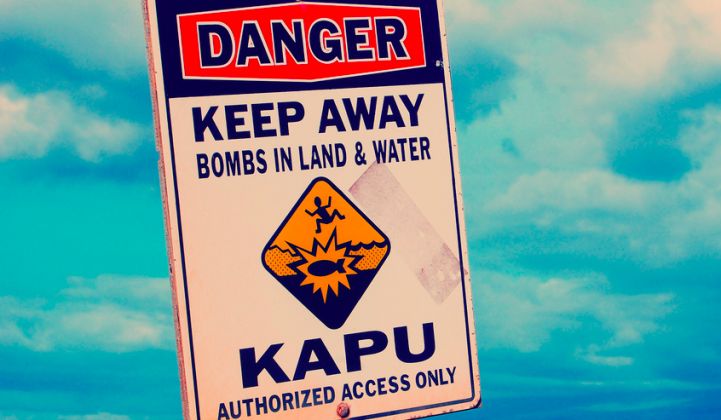When NextEra announced its intention to acquire Hawaii's utility, HECO, for $4.3 billion late last year, it was more like a formal marriage proposal among a very traditional set of families. Approval of the blessed union still has to make it past quite a few family members, community groups, and crazy uncles before it can be sealed.
The proposed acquisition has also spurred some thought over alternate outcomes.
Last week, the deal got the OK from the Federal Energy Regulatory Commission -- but that's just the first of many hurdles. The deal goes before Hawaiian Electric shareholders in a meeting scheduled for May 12. Hawaii's public utility commission (PUC) and a band of "intervenors" (approved stakeholders) are to consider the merger before the fall, which would push a final decision out until spring of next year.
Duane Shimogawa of Pacific Business News provided a list of the "intervenors" in the docket -- the stakeholders in the community and business world that will have an opportunity to weigh in on the deal. The intervenors include AES Hawaii (coal plant owner and operator), Blue Planet Foundation, Hawaii Gas, Ka Lei Maile Alii Hawaiian Civic Club, SunPower, SunEdison, Hawaii Island Energy Cooperative, Kauai Island Utility Cooperative, Puna Pono Alliance, The Alliance for Solar Choice, and the Department of Defense.
NextEra owns and operates about 17 percent of installed U.S. wind capacity, about 14 percent of installed U.S. utility-scale solar, and eight nuclear reactors. As of year-end 2013, the utility giant had revenues of approximately $15.1 billion, approximately 42,500 megawatts of generating capacity, and approximately 13,900 employees in the U.S. and Canada.
As Hawaii's utility, HEI supplies power to almost a half-million customers on Hawaii, Oahu and Maui. Hawaii has the nation's highest electricity prices, and roughly 75 percent of the island's electrical power comes from imported oil. The entire island chain of Hawaii has just 2,400 megawatts of generating capacity. One in nine Hawaiian residences are PV-powered, the highest percentage of solar penetration of any U.S. state. MJ Shiao, GTM Research solar director, comments, "HEI is the case study for high-penetration PV and the potential benefits and pitfalls of advanced PV integration regulations and technology."
The acquisition process has prompted Alan Arakawa, mayor of Maui County, to say, "We could start our own utility. We could purchase the electric companies. We could form cooperatives. We’ve been talking to Kauai and Big Island and some of the other users, potential power producers. We feel we could put it together," as quoted in the Star-Advertiser.
Maui is not the only island that is considering a co-op utility (Kauai's KIUC is already a co-op -- the Garden Island's inhabitants purchased the electric utility for $215 million in 2002). The Hawaii Island Energy Cooperative is also potentially proposing a co-op business model on the Big Island. Some contacts on the islands have suggested that Larry Ellison might be interested in taking over MECO on Lanai. Or Molokai's citizens might find that a co-op makes sense on the Friendly Island.
As a solar installer in Hilo noted, "Who would have thought that NextEra making a play for HEI just might lead to the dissolution of HEI as we've known it?"
Meanwhile on Molokai
The island of Molokai has 7,000 residents and boasts the highest per-capita percentage of rooftop solar in the island chain -- roughly 12 percent of residents have solar on their rooftops. Unfortunately, because of the high percentage of solar penetration on the Molokai grid, MECO just discontinued net metering on the island, citing "technical issues" with the grid.
During an occasionally contentious recent meeting between Maui Electric and the citizens of Molokai, the utility notified residents about its decision to discontinue net energy metering (NEM) on the island. Residents can still install solar, but will not be paid at previously established NEM rates -- and the utility will require some degree of control over the system. (Here's a video of the meeting.)
MECO's engineering director suggested that daytime PV's contribution to the grid had the potential to cause the island's fossil-fuel units to violate emissions standards and disturb the frequency of the grid. He noted that the island is working with inverter manufacturers "to make those [inverter] settings more friendly to the grid." Molokai has long-term plans for 10 megawatts of energy storage, 8 megawatts of centralized solar, and 3.2 megawatts of distributed PV. The diesel generators currently supplying power to the island are to be shifted to liquefied natural gas and biofuels.
The U.S. Energy Information Administration released a report on Hawaii’s solar status that lays out the state’s situation in graphic detail. Over the past five years, net-metered solar capacity has skyrocketed on the island of Oahu, and has also grown significantly on the smaller, more constrained grids of Maui and the Big Island.




